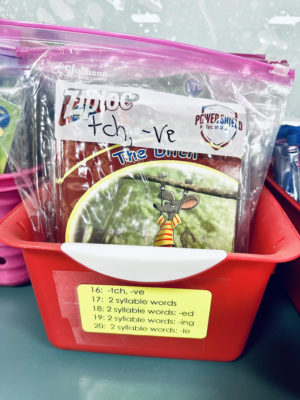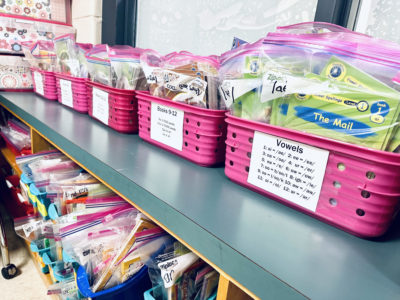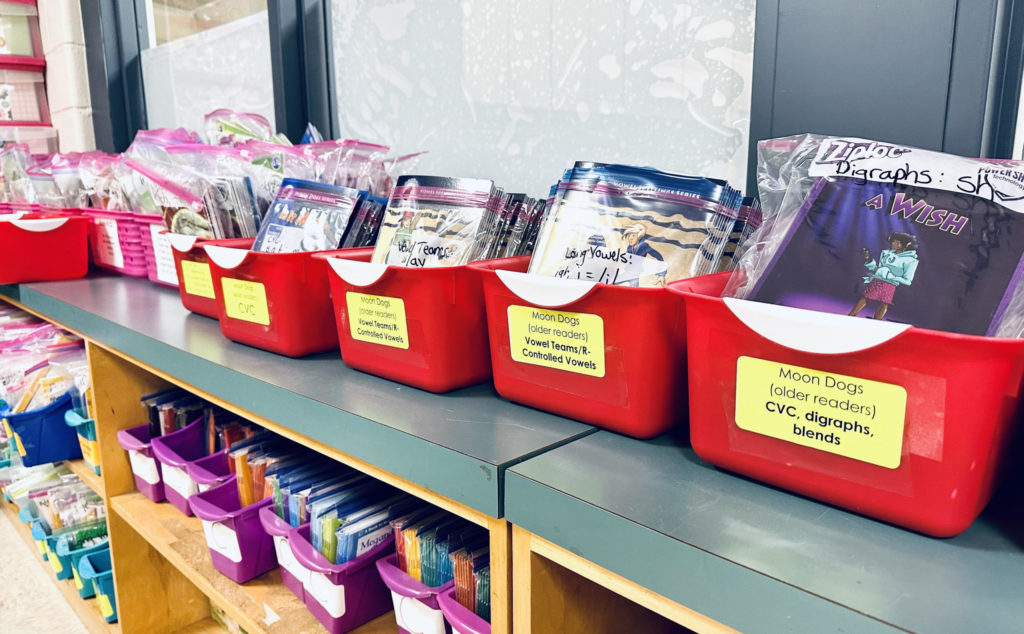What’s the best way to organize your decodables? There are many different ways to go about this. Here, K-5 reading specialist, Savannah Campbell, shares some helpful tips and tricks to make your classroom library user friendly.
Now that you have decodables, how do you organize them? I’m lucky to live in a district that has embraced structured literacy and purchased several sets of decodables. This year, my fellow reading specialist and I had the task of organizing them.

Originally, our goal was to keep all texts of the same skill together. So, we would put all the CVC books together, magic e, digraphs, blends, etc. What we quickly realized, however, is that many sets of decodables from publishers need to stay together. Different sets, like Phonic Books’ “Moon Dogs” Series, often feature the same characters and build upon the previous texts. It made more sense to organize our texts by sets rather than skill.
If you only have magazine holders, they will work, but baskets work much better for organizing books. The magazine holders tend to tip over when there are too many books in them. If possible, you want the titles to be facing forward—decodables don’t typically have titles on the spine. We put each set into a clear plastic bag and labelled them with the skill they are focusing on—digraphs, vowel teams, etc. Then, on the front of each basket, we put the same label. When teachers want to borrow a set, they take the entire bag out of the basket, and return it to that same basket when they are finished.
If you have a large selection of decodables, you may want to think about putting teacher names on clothespins. When they take a bag out of a basket, they can put the clothespin on the basket to mark their place. This can help teachers easily find where they took the books from if you have a large selection of books. It can also help identify who has certain books if another teacher is looking to borrow them.

But what about all those leveled texts you have? At my school, we have a book room that has been dominated by leveled texts for decades. Instead of throwing away or recycling leveled books (we do dispose of books that are old, stinky, or do not faithfully represent our students), we looked at organizing them in a different way. Once decoding is out of the way, it is vocabulary and background knowledge that are the biggest indicators of how well children will learn to read (Wexler, 2019).
Because we know the importance of background knowledge and vocabulary, we know that support content area is critical. We are taking those leveled texts and rearranging them according to theme and content, not levels. So, we might have a text set on natural resources that includes all the books we have on the topic, no matter the level. A teacher will be able to check out the text set and use all the books inside to build background knowledge and vocabulary around specific topics, without worrying about a “level”.
Nothing we do to organize our books is especially fancy or groundbreaking: we’re not looking for Pinterest-level cuteness, we are looking for efficiency. All you need is books, bags, and boxes to turn your decodable texts into a functional room. I recommend organizing by publisher sets, and make it as easy as possible to see what the skill is for each book within the boxes!
If you’re looking for decodable books to stock up your bags and boxes, check out Phonic Books‘ comprehensive range for both beginner and catch-up readers.
#decodablebooks #teachprimary #literacymatters #phonicbooks #campbellcreatesreaders
* * *
This guest blog is by K-5 reading specialist, Savannah Campbell. Savannah has taught her entire career at the school she went to as a child. She holds two master’s degrees in education from the College of William and Mary, and is both Orton-Gillingham and LETRS trained. Her greatest hope in life is to allow all children to live the life they want by helping them to become literate individuals.


